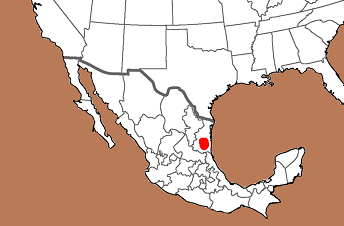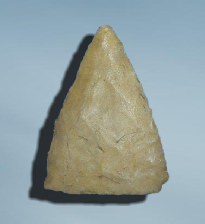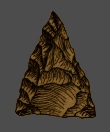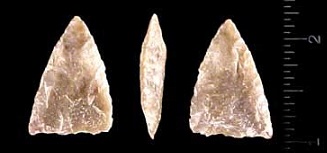Outline is Representative of Size and Shape:

Name Details:
Identified By: Richard "Scotty" MacNeish
Named For:
Date Identified: 1954
Type Site: Southern Tamaulipas, Mexico
Identified By: Richard "Scotty" MacNeish
Named For:
Date Identified: 1954
Type Site: Southern Tamaulipas, Mexico
Point Validity:
Valid type
MacNeish was a pioneering anthropologist who began his career studying the archeology of the Northern Plains and Canada. He was most notable for his excavations and studies at Tamaulipas Mexico. This type has been references in professional publications and is considered a valid type.
MacNeish was a pioneering anthropologist who began his career studying the archeology of the Northern Plains and Canada. He was most notable for his excavations and studies at Tamaulipas Mexico. This type has been references in professional publications and is considered a valid type.
Matamoros Triangle
Cluster: Late Southern Triangle Cluster Description of Physical Characteristics and Flaking Pattern:
This is a thick small triangular point with an elliptical cross section. The blade is primarily straight, but may vary to excurvate. Beveling may be seen on alternating, or both edges of the blade. The base may range from slightly convex to slightly concave. Basal thinning is commonly present. This point is manufactured using percussion flaking with pressure flaking used to finish shaping leaving a random flaking pattern.
Size Measurements:
Total Length - 20 to 44 mm (average 37 mm), Width - 15 to 27 mm (average 23 mm), Thickness - 4 to 10 mm (average 7 mm), (Suhm and Krieger, 1954, MacNeish, 1967)
Total Length - 20 to 44 mm (average 37 mm), Width - 15 to 27 mm (average 23 mm), Thickness - 4 to 10 mm (average 7 mm), (Suhm and Krieger, 1954, MacNeish, 1967)
Commonly Utilized Material:
Additional Comments:
This point is similar to the larger Tortugas point. This point varies form 20 to 40 mm while the Tortugas point ranges from 40 to 80 mm. Large examples of Matamoros that had width outside normal width, would be typed as a Tortugas while small examples of Tortugas that had a width narrower than normal would be typed as a Matamoros (Suhm and Krieger, 1954).
This type is commonly found with Catan type points. These points are newer than the similar larger Tortugas and Abasolo points. Matamoros and Catan points are found in association with pottery while Tortugas and Abasolo points are not (Suhm and Krieger, 1954).
This point is similar to the larger Tortugas point. This point varies form 20 to 40 mm while the Tortugas point ranges from 40 to 80 mm. Large examples of Matamoros that had width outside normal width, would be typed as a Tortugas while small examples of Tortugas that had a width narrower than normal would be typed as a Matamoros (Suhm and Krieger, 1954).
This type is commonly found with Catan type points. These points are newer than the similar larger Tortugas and Abasolo points. Matamoros and Catan points are found in association with pottery while Tortugas and Abasolo points are not (Suhm and Krieger, 1954).
Distribution:

Distribution Comments:
This point is primarily found in the Trans Pecos region, through out the Rio Grande River valley and into the Gulf Coastal regions of Texas and Tamaulipas. This type has been reported in Tehuacan Valley, , Mexico, and the Valley of Mexico. Frequency of this point decreases into central Texas and south of the Rio Grande Valley into Mexico. Bell (1958) places this type into Oklahoma.
This point is primarily found in the Trans Pecos region, through out the Rio Grande River valley and into the Gulf Coastal regions of Texas and Tamaulipas. This type has been reported in Tehuacan Valley, , Mexico, and the Valley of Mexico. Frequency of this point decreases into central Texas and south of the Rio Grande Valley into Mexico. Bell (1958) places this type into Oklahoma.
Age / Periods:
Date: 1,400 - 200 B.P.
Cultural Period: Transitional Archaic to Historic
Glacial Period: Vandal Minimum to Little Ice Age
Culture:
Age Details:
Other points in this cluster / Related / Associated Points:






